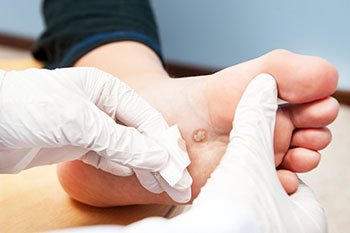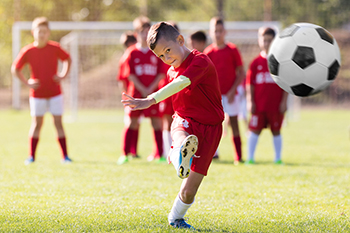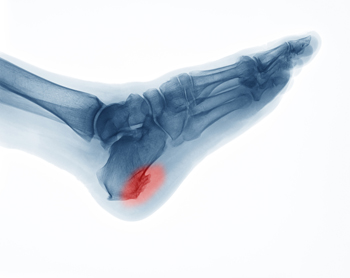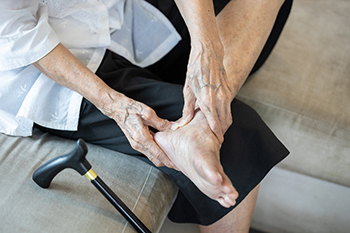Merrillville, IN
Munster, IN
August 2022
Foot Warts in Children

Plantar, or foot warts, are common in children. These warts are lumps that have hardened skin, are typically gray or brown in color, and have irregular surfaces. They are usually located on the heel or sole of the foot – areas that bear most body weight. Plantar warts are not always serious, but they can affect life quality. Foot warts in kids are caused by the human papillomavirus (HPV) and are aesthetically displeasing. Not all children with HPV will get plantar warts. They can occur from walking barefoot on floors containing the virus. Warm, wet areas, like public swimming pools, bathrooms, and changing rooms, are ideal breeding grounds for the virus. Oftentimes, there is a small wound on the foot, which provides an entrance for the foot wart. Plantar warts develop very slowly and may take up to a year to become visible. Symptoms vary depending on the location of the wart. They may hurt when walking and can get infected. If your child has a plantar wart, visit a podiatrist who can offer options for treatment.
Plantar warts can be very uncomfortable. If you need your feet checked, contact Ahmad Elsamad, DPM from The Institute of Foot & Ankle Reconstructive Surgery . Our doctor will assist you with all of your foot and ankle needs.
About Plantar Warts
Plantar warts are the result of HPV, or human papillomavirus, getting into open wounds on the feet. They are mostly found on the heels or balls of the feet.
While plantar warts are generally harmless, those experiencing excessive pain or those suffering from diabetes or a compromised immune system require immediate medical care. Plantar warts are easily diagnosed, usually through scraping off a bit of rough skin or by getting a biopsy.
Symptoms
- Lesions on the bottom of your feet, usually rough and grainy
- Hard or thick callused spots
- Wart seeds, which are small clotted blood vessels that look like little black spots
- Pain, discomfort, or tenderness of your feet when walking or standing
Treatment
- Freezing
- Electric tool removal
- Laser Treatment
- Topical Creams (prescription only)
- Over-the-counter medications
To help prevent developing plantar warts, avoid walking barefoot over abrasive surfaces that can cause cuts or wounds for HPV to get into. Avoiding direct contact with other warts, as well as not picking or rubbing existing warts, can help prevent the further spread of plantar warts. However, if you think you have developed plantar warts, speak to your podiatrist. He or she can diagnose the warts on your feet and recommend the appropriate treatment options.
If you have any questions please feel free to contact our offices located in Merrillville, and Munster, IN . We offer the newest diagnostic and treatment technologies for all your foot and ankle needs.
Finding the Right Shoe for Young Athletes

Children’s feet are not fully developed until the age of 18 or so. For this reason, parents need to be aware that the size and shape of their child’s foot may have changed since the last time they got new shoes. Kids involved in sports need special attention to their shoes to keep their feet healthy as they grow and play. Foot health experts suggest they wear padded socks made especially for cleated shoes or running shoes. Be certain that the child’s foot is measured properly while standing up to ensure a good fit. Bring along any orthotics or shoe inserts while fitting the shoes. Make sure the shoes fit and feel good to the child, checking that there is enough room in the toe box for the toes to wiggle. The shoes should not pinch, rub, or chafe. Have the child mimic any moves they make while playing their sport, and avoid buying shoes that need to be “broken in” after purchase. As a precaution, it is a good idea to have your child’s feet examined by a podiatrist who can offer suggestions on proper footwear for their sport.
Finding a properly-fitting shoe is important in reducing injuries and preventing foot problems. For more information about treatment, contact Ahmad Elsamad, DPM from The Institute of Foot & Ankle Reconstructive Surgery . Our doctor will treat your foot and ankle needs.
Proper Shoe Fitting
A common concern when it comes to foot health, having properly fitted shoes can help prevent injuries to the foot. Out feet affect our posture and gait, which in turn affects the biomechanics and overall bodily structure. With 33 joints, 26 bones, and over 100 ligaments, the potential for serious injury is much greater than one realizes. Although the feet cease growth in adulthood, they still change shape as they mature. Here are some factors to consider when it comes to investing in proper fitting shoes:
- Be sure the shoes fit correctly right away
- Ensure the ball of your foot fits comfortably in the widest portion of the shoes
- Even though they may look fashionable, improper fitting shoes can either create adverse conditions or exacerbate existing ones you may already have
- Walk along a carpeted surface to ensure the shoes comfortably fit during normal activity
Keeping in mind how shoes fit the biomechanics of your body, properly-fitting shoes are vitally important. Fortunately, it is not difficult to acquire footwear that fits correctly. Be sure to wear shoes that support the overall structure of your body. Do your feet a favor and invest in several pairs of well-fitted shoes today.
If you have any questions please feel free to contact our offices located in Merrillville, and Munster, IN . We offer the newest diagnostic and treatment technologies for all your foot and ankle needs.
Where is the Cuboid Bone Located?

The cuboid bone is located in the foot, and cuboid syndrome can occur when the surrounding joints and ligaments become inflamed. The pain is often felt on the outside of the foot where the pinky toe is, and may increase when weight is put on it. It can happen as a result of the cuboid bone moving outward as the heel bone moves inward, often from a sprain. Some people experience cuboid syndrome by putting repetitive strain on the foot while participating in running and jumping activities. There may be existing medical conditions that can lead to developing this condition. These include having flat feet or being obese. Additionally, having gout, arthritis and certain bone conditions may lead to getting cuboid syndrome. Effective preventive methods can include stretching the foot adequately before beginning an exercise routine, and it can be beneficial to wear shoes that have ample support. Treatment can begin with elevating the affected foot, and specific stretches and exercises can be done that can help to minimize discomfort. If you have this type of pain in your foot, please consult with a podiatrist as quickly as possible who can properly diagnose and treat this ailment.
Cuboid syndrome, also known as cuboid subluxation, occurs when the joints and ligaments near the cuboid bone in the foot become torn. If you have cuboid syndrome, consult with Ahmad Elsamad, DPM from The Institute of Foot & Ankle Reconstructive Surgery . Our doctor will assess your condition and provide you with quality foot and ankle treatment.
Cuboid syndrome is a common cause of lateral foot pain, which is pain on the outside of the foot. The condition may happen suddenly due to an ankle sprain, or it may develop slowly overtime from repetitive tension through the bone and surrounding structures.
Causes
The most common causes of cuboid syndrome include:
- Injury – The most common cause of this ailment is an ankle sprain.
- Repetitive Strain – Tension placed through the peroneus longus muscle from repetitive activities such as jumping and running may cause excessive traction on the bone causing it to sublux.
- Altered Foot Biomechanics – Most people suffering from cuboid subluxation have flat feet.
Symptoms
A common symptom of cuboid syndrome is pain along the outside of the foot which can be felt in the ankle and toes. This pain may create walking difficulties and may cause those with the condition to walk with a limp.
Diagnosis
Diagnosis of cuboid syndrome is often difficult, and it is often misdiagnosed. X-rays, MRIs and CT scans often fail to properly show the cuboid subluxation. Although there isn’t a specific test used to diagnose cuboid syndrome, your podiatrist will usually check if pain is felt while pressing firmly on the cuboid bone of your foot.
Treatment
Just as the range of causes varies widely, so do treatments. Some more common treatments are ice therapy, rest, exercise, taping, and orthotics.
If you have any questions, please feel free to contact our offices located in Merrillville, and Munster, IN . We offer the newest diagnostic and treatment technologies for all your foot care needs.
Runners and Heel Spurs

Heel spurs can be a pesky annoyance that may keep a runner off of the running track. Heel spurs are essentially bony outgrowths that can develop on the bottom of the heel facing inward. These heel spurs are typically made up of calcium deposits and they can cause discomfort. If you are diagnosed with heel spurs and cannot wait to get back on the running track, there are several things to keep in mind. Before running again, you can take extra care of your plantar fascia, the band of tissue that runs from your heel to your toes. You might do this by slowly and gently rolling a cold water bottle underneath your feet while in a seated position. You can do this one foot at a time. You might also perform heel drops carefully to slowly rebuild the muscles in your feet. Heel drops can be particularly helpful in targeting the plantar fascia and the calf muscles. Lastly, if you are cleared by a medical professional to begin running again, it is suggested to start slowly and cautiously. If you are a runner who has or is recovering from heel spurs, consider contacting a podiatrist who can help you.
Heel spurs can be incredibly painful and sometimes may make you unable to participate in physical activities. To get medical care for your heel spurs, contact Ahmad Elsamad, DPM from The Institute of Foot & Ankle Reconstructive Surgery . Our doctor will do everything possible to treat your condition.
Heels Spurs
Heel spurs are formed by calcium deposits on the back of the foot where the heel is. This can also be caused by small fragments of bone breaking off one section of the foot, attaching onto the back of the foot. Heel spurs can also be bone growth on the back of the foot and may grow in the direction of the arch of the foot.
Older individuals usually suffer from heel spurs and pain sometimes intensifies with age. One of the main condition's spurs are related to is plantar fasciitis.
Pain
The pain associated with spurs is often because of weight placed on the feet. When someone is walking, their entire weight is concentrated on the feet. Bone spurs then have the tendency to affect other bones and tissues around the foot. As the pain continues, the feet will become tender and sensitive over time.
Treatments
There are many ways to treat heel spurs. If one is suffering from heel spurs in conjunction with pain, there are several methods for healing. Medication, surgery, and herbal care are some options.
If you have any questions feel free to contact our offices located in Merrillville, and Munster, IN . We offer the latest in diagnostic and treatment technology to meet your needs.
Are You Suffering From Ingrown Toenails?
Foot Conditions That Can Affect Elderly People

There are several reasons why many elderly people can experience uncomfortable foot conditions. These include a loss of cushioning as the aging process occurs, and the skin and nails can become brittle. Additionally, many seniors develop foot sores, and this may be a result of poor circulation. One of the best things elderly people can do for their feet is to wear shoes that are comfortable, and to refrain from wearing high heels. Research has shown the feet can become wider in later years, and it is important to have them properly measured before purchasing shoes. The feet can feel better when specific stretching techniques are frequently performed, in addition to avoiding wearing socks that are too tight. Common foot conditions can consist of dry, cracked heels, corns and heel spurs. These may be able to be avoided when a good moisturizer is used daily, and the shoes that are worn fit properly. Additionally, many patients can develop hammertoes and ingrown toenails which often need medical treatment. If you would like more information about what foot conditions can affect seniors and how to treat and prevent them, please consult with a podiatrist.
Proper foot care is something many older adults forget to consider. If you have any concerns about your feet and ankles, contact Ahmad Elsamad, DPM from The Institute of Foot & Ankle Reconstructive Surgery . Our doctor can provide the care you need to keep you pain-free and on your feet.
The Elderly and Their Feet
As we age we start to notice many changes in our body, but the elder population may not notice them right away. Medical conditions may prevent the elderly to take notice of their foot health right away. Poor vision is a lead contributor to not taking action for the elderly.
Common Conditions
- Neuropathy – can reduce feeling in the feet and can hide many life-threatening medical conditions.
- Reduced flexibility – prevents the ability of proper toenail trimming, and foot cleaning. If left untreated, it may lead to further medical issues.
- Foot sores – amongst the older population can be serious before they are discovered. Some of the problematic conditions they may face are:
- Gouging toenails affecting nearby toe
- Shoes that don’t fit properly
- Pressure sores
- Loss of circulation in legs & feet
- Edema & swelling of feet and ankles
Susceptible Infections
Diabetes and poor circulation can cause general loss of sensitivity over the years, turning a simple cut into a serious issue.
If you have any questions please feel free to contact our offices located in Merrillville, and Munster, IN . We offer the newest diagnostic and treatment technologies for all your foot and ankle needs.








